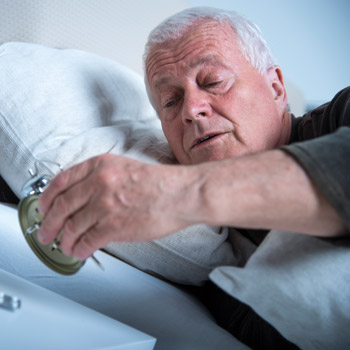Be wary of benzodiazepines' side effects
Alternative strategies are increasingly recommended when managing conditions like insomnia and anxiety in elderly patients.
It's a familiar story: A drug class appears to provide a solution to intractable problems that are particularly common among older adults. The initial effects are so satisfying to clinicians and patients that prescribing becomes widespread. But then damaging side effects, including dependence, start to become apparent.
“Now we're trying to figure out what are the best ways to get rid of these medications, because they're not innocuous,” said Joshua Niznik, PharmD, PhD, an assistant professor at the University of North Carolina in Chapel Hill.

One might assume he's talking about opioids, but benzodiazepines are the target of efforts by Dr. Niznik and other experts to make prescribing for geriatric patients safer. Recent events, particularly the pandemic, have increased the difficulty of this challenge but also highlighted its importance.
“Patients will call in very distressed, very anxious, overwhelmed, requesting medications to help them feel better,” said Lauren Gerlach, DO, MSc, an assistant professor of psychiatry at the University of Michigan in Ann Arbor. “During COVID, when it was very difficult for people to come in for routine office visits, there can be a tendency to want to do something to help the patient immediately, and so sometimes these prescriptions are started.”
Although clinicians prescribing benzodiazepines mean to help patients with anxiety or insomnia, the end result, especially for older adults, can often be harm, according to experts, recent research, and regulatory agencies.
Evolving understanding
Benzodiazepines long had a positive reputation among patients, pop culture, and prescribers. “There was a big push back when benzodiazepines first came out that ‘We can use this for sleep—it's great,’ and I think that that really drove a lot of the ongoing prescribing that we still see,” said Dr. Niznik.
Clinicians' perspectives have gradually changed. “There has been a growing recognition over the past several years regarding the danger of using this class of medications with older adults in particular,” said Dr. Gerlach. Those age-specific risks include falls (potentially resulting in fractures), confusion, and overdoses, she noted.
“Patients can be dependent on them as well,” added Dr. Niznik. In September 2020, the FDA revised the drug class's black box warning to alert patients and clinicians to the risk of misuse, abuse, and addiction. Previously, the black box had only highlighted the problems that benzodiazepines pose when taken with opioids.
That combination of drugs has been a focus of attention and research for Wayne Ray, PhD, a professor of health policy at Vanderbilt University Medical Center in Nashville, Tenn. “For many years, there has been a concern that the risks of these drugs go beyond habituation and injuries,” he said. “In particular, there are numerous studies that associate them with increased risk of death of any kind.”
To investigate this further, Dr. Ray and colleagues recently studied the records of more than 400,000 Medicare beneficiaries starting therapy with either a benzodiazepine or another hypnotic. Their results, published by PLOS Medicine on July 15, 2021, found that patients who took both a benzo and an opioid had more than twice the mortality rate of those taking trazodone, a drug used as a control comparison.
That was after overdose deaths were excluded, leading Dr. Ray and colleagues to speculate that cardiac arrhythmias and breathing changes, known to be related to these medications, might be at least partly responsible. “There are already good reasons to be careful about using these drugs,” he said. “What our research says is worrying about cardiovascular deaths is now another reason to add to the list.”
Recent trends
The growing evidence on the risks of benzodiazepines had led researchers like Michelle Keller, PhD, MPH, to work on reducing prescriptions to older patients in recent years. “We had already developed a dashboard to look at the number of 30-day prescriptions, the number of starts, and how many prescriptions were for shorter-acting benzodiazepines,” said Dr. Keller, an epidemiologist with Cedars-Sinai Medical Center in Los Angeles.
She and colleagues reported recent data from their dashboard in the Journal of General Internal Medicine on May 13, 2021. They looked at benzodiazepine prescribing in the primary care practices of a Southern California health system from June 30, 2019, to Sept. 27, 2020.
“Despite many of the interventions that we were trying to implement to reduce benzodiazepine prescribing, we were seeing an increase in prescribing over the pandemic,” she reported. In fact, the study showed that benzodiazepine prescriptions were already on the rise in 2019, stabilized somewhat in the early pandemic, and then headed sharply up again in late summer 2020.
That was surprising and concerning, Dr. Keller noted. “We thought that prescribing would level off, that, for example, there would be this initial jump, and then people would find coping mechanisms or different mental health resources.” Instead, “prescribing just continued to go up throughout 2020,” she said, adding, “If you look at the news events of last year, it's maybe not so surprising.”
The factor that drove patients and their physicians to benzodiazepines might also have been closer to home. A research letter published by JAMA Internal Medicine on July 26, 2021, compared community-dwelling older adults' medication use and health problems to their scores on a loneliness scale. Loneliness was significantly associated with self-reported pain, insomnia, depression, and anxiety, as well as use of several kinds of medications, including benzodiazepines.
Only 5% of patients who weren't lonely took benzodiazepines, compared to 7% of those who were a little or moderately lonely, and 11% of those who were highly lonely, according to the 2005 to 2015 data. “That just speaks to how much emotional distress people can experience from loneliness, and how often these symptoms can coexist,” said lead study author Ashwin Kotwal, MD, assistant professor of geriatrics at the University of California, San Francisco.
The surveys were conducted before the pandemic, but Dr. Kotwal's clinical experience suggests the situation has only gotten worse.
“When I have seen people in clinic who complain of pain and loneliness, for example, many of them have lost a lot of the traditional coping mechanisms that they use,” he said. “They may not have their grandchildren to distract them from their back pain, they may not be able to go out with their neighbor and share a meal, … and so they may be needing more medications to cope with what's going on.”
Alternative solutions
When faced with an older patient who needs help coping, internists should think twice before turning to benzodiazepines, said the experts, who offered a number of other strategies.
“What I've been doing in clinic is being a little bit more intentional about asking about loneliness among individuals, even if their primary complaint is pain or difficulty sleeping,” said Dr. Kotwal. “When people tell me that they feel lonely, that those feelings are frequent, I ask them, ‘What might help? What are some of the things that you think may improve the situation?’” (For more about combating loneliness in homebound adults, see the Success Story in this issue.)
Some patients can be guided to their own solutions, while others can be connected to community resources. “For example, I have many older patients who really want to volunteer … and so we connect them with programs where they can do that,” he said. “I work with different people on our clinic staff, social workers, community health workers, other organizations, to figure out what resources might be available locally.”
If the patient's problem is pandemic-related anxiety, “acknowledging the general stress that a lot of people are feeling right now and kind of normalizing those stressors and feelings” can be helpful, said Dr. Gerlach, who also recommended discussing behavioral strategies that can reduce anxiety, including a good sleep schedule and exercise time.
“In the context of a routine outpatient visit, and especially with telehealth, it can be very hard to carve in these discussions of behavioral strategies and interventions to help manage anxiety, insomnia, and depression. But really, those strategies can have the longest-lasting impact for patients,” she said.
If lifestyle interventions appear insufficient, physicians should be “thinking about referrals to individual psychotherapy as well as thinking about a time and a place for antidepressant medications,” Dr. Gerlach said.
Compared to benzodiazepines, “there are better ways of managing anxiety and insomnia,” agreed Dr. Keller. “A physician might prescribe an SSRI for somebody who is really experiencing high degrees of anxiety, and that's a potentially safer medication for older adults.”
There are other options for insomnia treatment, as well. “Many people are using trazodone as a preferred hypnotic for older patients because it doesn't have the issues of injuries and habituation,” said Dr. Ray. “On the other hand, the knowledge base for trazodone is very small. It's basically an old antidepressant that's being used off label for insomnia, and it's a bit dangerous to use a medication with so little information about its risks and benefits.”
Physicians seeking more information about these drugs should remember their pharmacists are there to help, said Dr. Niznik. He was the lead author on a recent review of pharmacist interventions to deprescribe opioids and benzodiazepines in older adults, published by Research in Social and Administrative Pharmacy on July 16, 2021, and is now working on a large related project funded by the CDC.
“We're trying to use pharmacists to deprescribe benzodiazepines for older adults in primary care clinics in North Carolina right now,” he said. Keys to success in that effort appear to be establishing ongoing relationships between physicians and pharmacists and providing patients with a clear plan for either the prescriber or the pharmacist to check in and address problems that arise, he advised.
Clinicians who choose to prescribe benzodiazepines should always have a plan, recommended Dr. Gerlach. “If we do feel that it's clinically indicated to prescribe the medication, we're providing a short prescription with a limited number of pills, and we're explaining to the patient what our plan will be for them to get off of this medication. … We always want to start with the end in mind.”
The importance of this step was highlighted by a study she and colleagues published in JAMA Internal Medicine in 2018. It included 576 older adults who were newly prescribed benzodiazepines by their primary care clinicians.
“We looked to see how many of them stayed on the medication long term. It was greater than one in four,” said Dr. Gerlach. “The greatest predictor was a larger prescription during that initial prescription filled. Basically, for every 10 additional pills of benzodiazepine that they received, they were twice as likely to still be on the medication a year later.”
Physicians appear to be absorbing the lesson, according to Dr. Keller's research on benzodiazepine use during the pandemic. “What we did find, which was good news, was that most prescriptions were for under 30 days,” she said.
That finding offers hope that benzodiazepines may not re-enact the entire stark story of opioids, according to Dr. Keller. As researchers highlight the risks of the drugs, physicians have also been urging attention to the issue.
“They would say there's also a high wave of benzo prescribing that we should be taking a look at,” she said. “I think we have to do a lot of education for patients and policymakers,” as well as more measurement of the use of the drugs across health systems and the country, she recommended.
“We're now seeing that with opioids,” said Dr. Keller. “We haven't seen the same thing for benzodiazepines. I think some of those initiatives at a higher level could really make a dent in this issue.”



